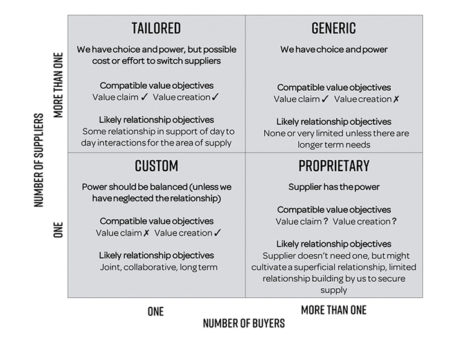While predominantly used in Category Management and Supplier Relationship Management, Day One Analysis is helpful for negotiation planning – particularly when sourcing goods and services.
Day One Analysis can be used to give an insight into what leverage or opportunities might exist, then help to determine the value and relationship objectives that would be most compatible with the negotiation.
To use it, plot on a matrix the categories, areas of spend or products that you are planning to negotiate. Do this according to the number of suppliers that could potentially supply the category or item, against the number of buyers. Make sure you fully understand the axes for this analysis. They are not sliding scales and, while there may be either one or more supplier or buyer, there is no middle ground.
It is helpful to do day one analysis in a group, as it will typically spark discussions regarding differences in outcomes or positioning, depending on how people view the goods or services they are attempting to negotiate. This type of discussion is good and differences will often reveal insights into what is happening.

Potential negotiation approaches for each of the quadrants are as follows:
Generic
This is where there are many suppliers and many buyers. In this quadrant, we have the greatest choice and ability to switch, so the power lies with us. For a single negotiation, it is unlikely that we will need an ongoing relationship with the supplier unless, of course, there are wider or longer term needs. The supplier’s mindset is about beating the competition, so a value claiming negotiation stance is normally the most suitable approach.
Tailored
Here the products and services are made uniquely for the organisation so while there could be many suppliers, there will be only one buyer. Anything that is branded or made to a unique, business-owned specification or drawing fits here. The supplier’s focus is on selling its process and capability. Because of this, we may need some sort of relationship with the supplier, perhaps to facilitate day-to-day interactions between companies that support the tailored goods or services.
As there is more than one supplier, we also hold the power here so, in theory, it is possible to switch suppliers to gain the best value. However, switching may not be as straightforward as it seems in the generic quadrant. There may be issues around the transition, ensuring the new supplier is fully aware of our specific requirements, the manufacturing or service provision process. Depending upon the circumstances, we could adopt a value claiming negotiation approach, but equally we may benefit from a degree of value creation.
Custom
As the name suggests, this quadrant features the things that are custom-made for us by just one supplier. Either we or the supplier may have a unique process or patented component and the arrangement in place could stipulate that it can only be made by or sold to the other party. Here, we will undoubtedly need a strong, collaborative and perhaps long term relationship with the supplier. It’s important to keep in mind that the supplier may have accumulated certain know-how regarding the manufacture or service provision, so our dependency on them is increased. The balance of power between us and the supplier would most likely be shared but that’s assuming we have managed the relationship well. Value claiming negotiation approaches would be entirely inappropriate and here value creation would typically yield the best outcomes.
Proprietary
Proprietary, where this is one supplier but many buyers, is where suppliers ideally want you to be, as it gives them the power and a degree of control. Suppliers are very clever and will work to identify ways in which you go to only them for their products. Some of the ways that they do this include:
- branding;
- differentiation – by making a product or service unique in some way;
- added value – by including additional products or services with the aim of creating real or perceived additional value for your money;
- convincing a design team to specify make and part number on a drawing or specification; and
- bundling different generic or tailored products and services together to create a unique offering.
In Proprietary, the supplier does not need a relationship with us, but may cultivate a superficial one to shore up their position. There is little point in us attempting to build a collaborative relationship with them, however there is benefit in building a similar superficial relationship that seeks to make and keep us attractive to the supplier. This can help to secure the best terms given the constraints.
In terms of value objectives, we have little power to drive value claiming and value creation could end up a one-way street on our part, yet both approaches are valid and work to a degree providing the constraints are kept in mind.
A Powerful Tool
Day One Analysis is a powerful tool that both helps us understand our current position and what scope we might have, if any, to negotiate and then helps us to determine what sort of negotiation we should conduct if we are to maximise our outcomes. It is simple to understand and simple to apply but can make the world of difference.
This article has been adapted from Negotiation for Procurement Professionals (2nd Edition) by Jonathan O’Brien © 2016, published by Kogan Page (9780749477301). Jonathan is CEO of Positive Purchasing, a leading expert on negotiation and helped pioneer the Red Sheet® Negotiation methodology. This article first appeared as an invited contribution to the Procurement Leaders Blog.

